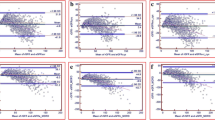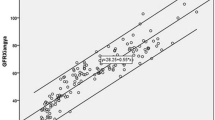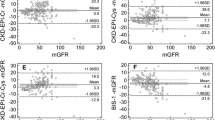Abstract
Background
Newly proposed estimating glomerular filtration rate equations need to be studied, evaluated and compared for chronic kidney disease staging, diagnosis and medication dosing in South Asians. The objectives of the study were (1) to assess the performance of the CKD-EPIPK, CKD-EPIAsian-Modified, and LMRevised equations in the Pakistani chronic kidney disease population, and (2) to investigate prospective implications on chronic kidney disease classification and end-stage kidney disease prevalence.
Methods
We conducted a cross-sectional analysis on a chronic kidney disease cohort of 385 participants 18 years of age or above.
Results
CKD-EPIPK showed the lowest bias (− 1.33 ml/min/1.73 m2), highest precision [IQR, 2.33 (− 2.36, − 0.03)] and enhanced P30 accuracy (89.35%) compared to the CKD-EPIAsian-Modified and LMRevised equations. The mean difference (ml/min/1.73 m2), 95% limit of agreement (ml/min/1.73 m2) of the equations were; CKD-EPIAsian-Modified: − 5.98, − 13.03, LMRevised: − 4.06, − 8.13 and CKD-EPIPK: − 1.18, − 6.14 (P < 0.001). CKD-EPIAsian-Modified and LMRevised showed upward re-classification of the GFR categories compared to the CKD-EPIPK equation except in the G5 category where the highest count (217, 56.36%) was noted for the CKD-EPIPK equation. End-stage kidney disease prevailed in all age groups according to all equations, and the prevalence was high in females in all equations.
Conclusion
CKD-EPIPK showed the best performance, whereas both CKD-EPIAsian-Modified and LMRevised showed poor performance and did not offer a sufficient advantage in chronic kidney disease classification and end-stage kidney disease prevalence estimation over CKD-EPIPK. Hence, CKD-EPIPK seems ideal for South Asians, thus appropriate measures should be taken for its implementation, at least in Pakistani laboratories.
Graphical abstract




Similar content being viewed by others
References
Vos T et al (2020) Global burden of 369 diseases and injuries in 204 countries and territories, 1990–2019: a systematic analysis for the Global Burden of Disease Study 2019. Lancet 396(10258):1204–1222
Hasan M et al (2018) Prevalence of chronic kidney disease in South Asia: a systematic review. BMC Nephrol 19(1):1–12
Jafar TH, Schmid CH, Levey AS (2005) Serum creatinine as marker of kidney function in South Asians: a study of reduced GFR in adults in Pakistan. J Am Soc Nephrol 16(5):1413–1419
Jessani S, Bux R, Jafar TH (2014) Prevalence, determinants, and management of chronic kidney disease in Karachi, Pakistan—a community based cross-sectional study. BMC Nephrol 15(1):1–9
Andrassy KM (2013) Comments on ‘KDIGO 2012 clinical practice guideline for the evaluation and management of chronic kidney disease.’ Kidney Int 84(3):622–623
Levey AS et al (2020) Measured and estimated glomerular filtration rate: current status and future directions. Nat Rev Nephrol 16(1):51–64
Björk J et al (2011) Revised equations for estimating glomerular filtration rate based on the Lund–Malmö Study cohort. Scand J Clin Lab Invest 71(3):232–239
Nyman U et al (2014) The revised Lund–Malmö GFR estimating equation outperforms MDRD and CKD-EPI across GFR, age and BMI intervals in a large Swedish population. Clin Chem Lab Med (CCLM) 52(6):815–824
Björk J et al (2020) A novel method for creatinine adjustment makes the revised Lund–Malmö GFR estimating equation applicable in children. Scand J Clin Lab Invest 80(6):456–463
Björk J et al (2012) Validation of the Lund–Malmö, chronic kidney disease epidemiology (CKD-EPI) and modification of diet in renal disease (MDRD) equations to estimate glomerular filtration rate in a large Swedish clinical population. Scand J Urol Nephrol 46(3):212–222
Björk J et al (2015) Performance of GFR estimating equations stratified by measured or estimated GFR: implications for interpretation. Am J Kidney Dis 66(6):1107–1108
Ji M et al (2016) Comparing results of five glomerular filtration rate-estimating equations in the Korean general population: MDRD Study, revised Lund–Malmö, and three CKD-EPI equations. Ann Lab Med 36(6):521
Jeong T-D et al (2017) Accuracy assessment of five equations used for estimating the glomerular filtration rate in Korean adults. Ann Lab Med 37(5):371–380
Stevens LA et al (2011) Evaluation of the chronic kidney disease epidemiology collaboration equation for estimating the glomerular filtration rate in multiple ethnicities. Kidney Int 79(5):555–562
Wang J et al (2016) The new Asian modified CKD-EPI equation leads to more accurate GFR estimation in Chinese patients with CKD. Int Urol Nephrol 48(12):2077–2081
Ji H et al (2017) eGFRs from Asian-modified CKD-EPI and Chinese-modified CKD-EPI equations were associated better with hypertensive target organ damage in the community-dwelling elderly Chinese: the Northern Shanghai Study. Clin Interv Aging 12:1297
Gao J-Q et al (2021) Comparative performance of FAS equation and Asian modified CKD-EPI in the determination of GFR in Chinese patients with CKD with the 99mTc-DTPA plasma clearance as the reference method. Nefrologia 41(1):27–33
Zhao L et al (2021) The ensemble learning model is not better than the Asian modified CKD-EPI equation for glomerular filtration rate estimation in Chinese CKD patients in the external validation study. BMC Nephrol 22(1):1–8
Jessani S et al (2014) Estimation of GFR in South Asians: a study from the general population in Pakistan. Am J Kidney Dis 63(1):49–58
Major RW et al (2022) Comorbidities and outcomes in South Asian individuals with chronic kidney disease: an observational primary care cohort. Nephrol Dial Transplant 37(1):108–114
Wang Y et al (2022) Performance of serum β2-microglobulin–and β-trace protein–based panel markers and 2021 creatinine-and cystatin-based GFR estimating equations in Pakistan. Kidney Med 4(4):100444
Ahmed S, Jafri L, Khan AH (2017) Evaluation of’CKD-EPI Pakistan’equation for estimated glomerular filtration rate (eGFR): a comparison of eGFR prediction equations in Pakistani population. J Coll Phys Surg Pak 27(7):414
Kidney Disease Improving Global Outcomes (2012) KDIGO 2012 clinical practice guideline for the evaluation and management of chronic kidney disease. Available from https://kdigo.org/wp-content/uploads/2017/02/KDIGO_2012_CKD_GL.pdf. Accessed 18 Mar 2023
Mukaka MM (2012) A guide to appropriate use of correlation coefficient in medical research. Malawi Med J 24(3):69–71
McHugh ML (2012) Interrater reliability: the kappa statistic. Biochem Med 22(3):276–282
Liu X et al (2014) A new modified CKD-EPI equation for Chinese patients with type 2 diabetes. PLoS One 9(10):e109743
Trocchi P et al (2017) Impact of the estimation equation for GFR on population-based prevalence estimates of kidney dysfunction. BMC Nephrol 18(1):1–10
Kim H et al (2022) European Kidney Function Consortium Equation vs. Chronic Kidney Disease Epidemiology Collaboration (CKD-EPI) refit equations for estimating glomerular filtration rate: comparison with CKD-EPI equations in the Korean population. J Clin Med 11(15):4323
Anothaisintawee T et al (2009) Prevalence of chronic kidney disease: a systematic review and meta-analysis. Clin Nephrol 71(3):244
Glassock RJ, Warnock DG, Delanaye P (2017) The global burden of chronic kidney disease: estimates, variability and pitfalls. Nat Rev Nephrol 13(2):104–114
Kitiyakara C et al (2012) The impact of different GFR estimating equations on the prevalence of CKD and risk groups in a Southeast Asian cohort using the new KDIGO guidelines. BMC Nephrol 13(1):1–9
Duggal V et al (2021) National estimates of CKD prevalence and potential impact of estimating glomerular filtration rate without race. J Am Soc Nephrol 32(6):1454–1463
Pottel H et al (2021) Development and validation of a modified full age spectrum creatinine-based equation to estimate glomerular filtration rate: a cross-sectional analysis of pooled data. Ann Intern Med 174(2):183–191
Inker LA et al (2021) New creatinine-and cystatin C–based equations to estimate GFR without race. N Engl J Med 385(19):1737–1749
Jonker N et al (2020) Critical appraisal and meta-analysis of biological variation estimates for kidney related analytes. Clin Chem Lab Med (CCLM) 60(4):469–478
Schmidt RL et al (2015) A risk assessment of the Jaffe vs enzymatic method for creatinine measurement in an outpatient population. PLoS ONE 10(11):e0143205
Küme T et al (2018) Evaluation and comparison of Abbott Jaffe and enzymatic creatinine methods: could the old method meet the new requirements? J Clin Lab Anal 32(1):e22168
Acknowledgements
None declared.
Author information
Authors and Affiliations
Contributions
WA conceived and supervised the study. AS conducted data collection and data analysis. AS wrote and edited the manuscript. WA, MAK and MNA reviewed and approved the paper.
Corresponding author
Ethics declarations
Conflict of interest
All the authors declare no competing interests. The authors had full responsibility for data collection, data interpretation, and writing of the report.
Research funding
None declared.
Ethical approval
This study was approved by the Ethical Review Board of Allama Iqbal Medical College, Jinnah Hospital (ERB No. 167/23/12/2021/S2 ERB) in its 108th meeting dated: 23/12/2021.
Informed consent
Informed consent to participate in the study was obtained from all participants.
Data availability
All data generated or analyzed during this study are included in the published article and its supplementary information files.
Additional information
Publisher's Note
Springer Nature remains neutral with regard to jurisdictional claims in published maps and institutional affiliations.
Supplementary Information
Below is the link to the electronic supplementary material.
Rights and permissions
Springer Nature or its licensor (e.g. a society or other partner) holds exclusive rights to this article under a publishing agreement with the author(s) or other rightsholder(s); author self-archiving of the accepted manuscript version of this article is solely governed by the terms of such publishing agreement and applicable law.
About this article
Cite this article
Safdar, A., Akram, W., Khan, M.A. et al. Comparison of Pakistani CKD-EPI, new Asian-modified CKD-EPI and revised Lund–Malmö study equations in a South Asian CKD population: a study from a Pakistani CKD cohort. J Nephrol 37, 119–129 (2024). https://doi.org/10.1007/s40620-023-01749-y
Received:
Accepted:
Published:
Issue Date:
DOI: https://doi.org/10.1007/s40620-023-01749-y




